Change Management: Principles, Planning, and Monitoring in Healthcare
VerifiedAdded on 2021/02/20
|8
|1467
|22
Report
AI Summary
This report focuses on facilitating change within health and social care services, specifically using the example of Local Action for Disabled (LAD). It explores the key principles of change management, including John Kotter's model, and details how changes are planned and implemented, emphasizing stakeholder and communication strategies. The report also examines methods for monitoring recent changes within healthcare, such as observation and surveys. It highlights the need for continuous development to improve services and meet current technological demands. The report covers various aspects, including establishing a sense of urgency, forming strong coalitions, and creating a vision for the future. Additionally, it offers insights into stakeholder management, communication plans, and issue log monitoring to ensure effective change implementation. References to relevant literature are provided to support the analysis.
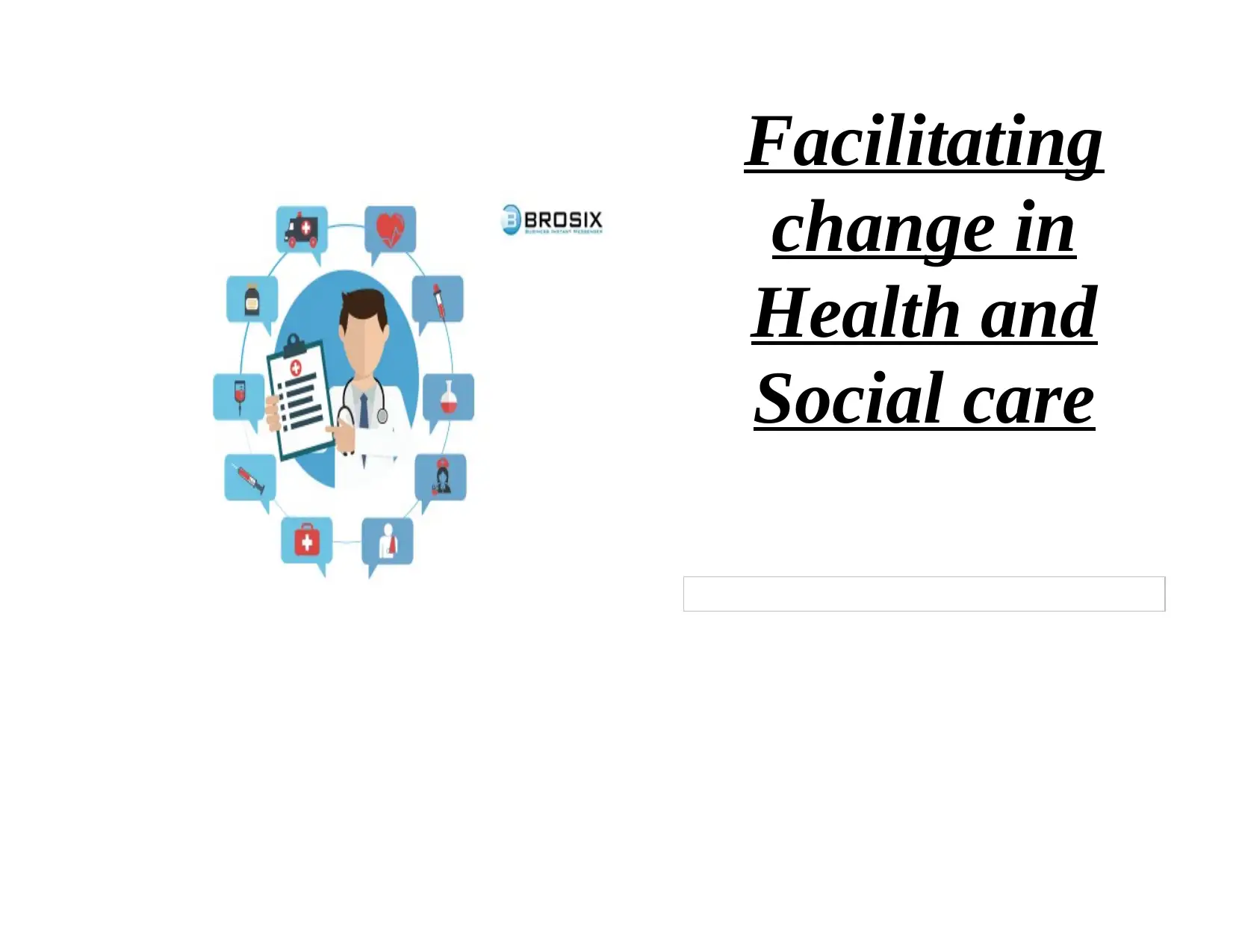
Facilitating
change in
Health and
Social care
change in
Health and
Social care
Paraphrase This Document
Need a fresh take? Get an instant paraphrase of this document with our AI Paraphraser
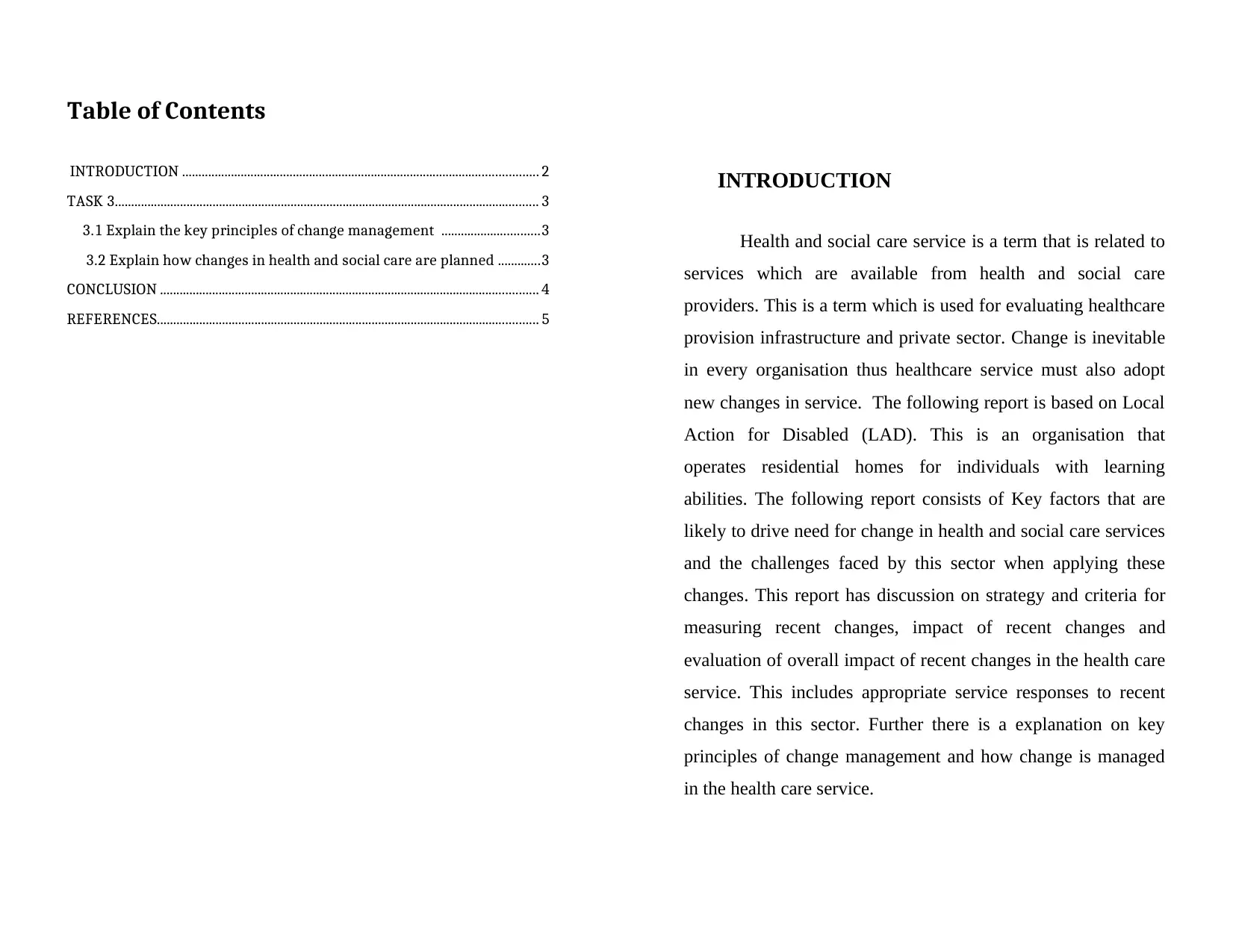
Table of Contents
INTRODUCTION ............................................................................................................. 2
TASK 3.................................................................................................................................. 3
3.1 Explain the key principles of change management ..............................3
3.2 Explain how changes in health and social care are planned .............3
CONCLUSION .................................................................................................................... 4
REFERENCES..................................................................................................................... 5
INTRODUCTION
Health and social care service is a term that is related to
services which are available from health and social care
providers. This is a term which is used for evaluating healthcare
provision infrastructure and private sector. Change is inevitable
in every organisation thus healthcare service must also adopt
new changes in service. The following report is based on Local
Action for Disabled (LAD). This is an organisation that
operates residential homes for individuals with learning
abilities. The following report consists of Key factors that are
likely to drive need for change in health and social care services
and the challenges faced by this sector when applying these
changes. This report has discussion on strategy and criteria for
measuring recent changes, impact of recent changes and
evaluation of overall impact of recent changes in the health care
service. This includes appropriate service responses to recent
changes in this sector. Further there is a explanation on key
principles of change management and how change is managed
in the health care service.
INTRODUCTION ............................................................................................................. 2
TASK 3.................................................................................................................................. 3
3.1 Explain the key principles of change management ..............................3
3.2 Explain how changes in health and social care are planned .............3
CONCLUSION .................................................................................................................... 4
REFERENCES..................................................................................................................... 5
INTRODUCTION
Health and social care service is a term that is related to
services which are available from health and social care
providers. This is a term which is used for evaluating healthcare
provision infrastructure and private sector. Change is inevitable
in every organisation thus healthcare service must also adopt
new changes in service. The following report is based on Local
Action for Disabled (LAD). This is an organisation that
operates residential homes for individuals with learning
abilities. The following report consists of Key factors that are
likely to drive need for change in health and social care services
and the challenges faced by this sector when applying these
changes. This report has discussion on strategy and criteria for
measuring recent changes, impact of recent changes and
evaluation of overall impact of recent changes in the health care
service. This includes appropriate service responses to recent
changes in this sector. Further there is a explanation on key
principles of change management and how change is managed
in the health care service.
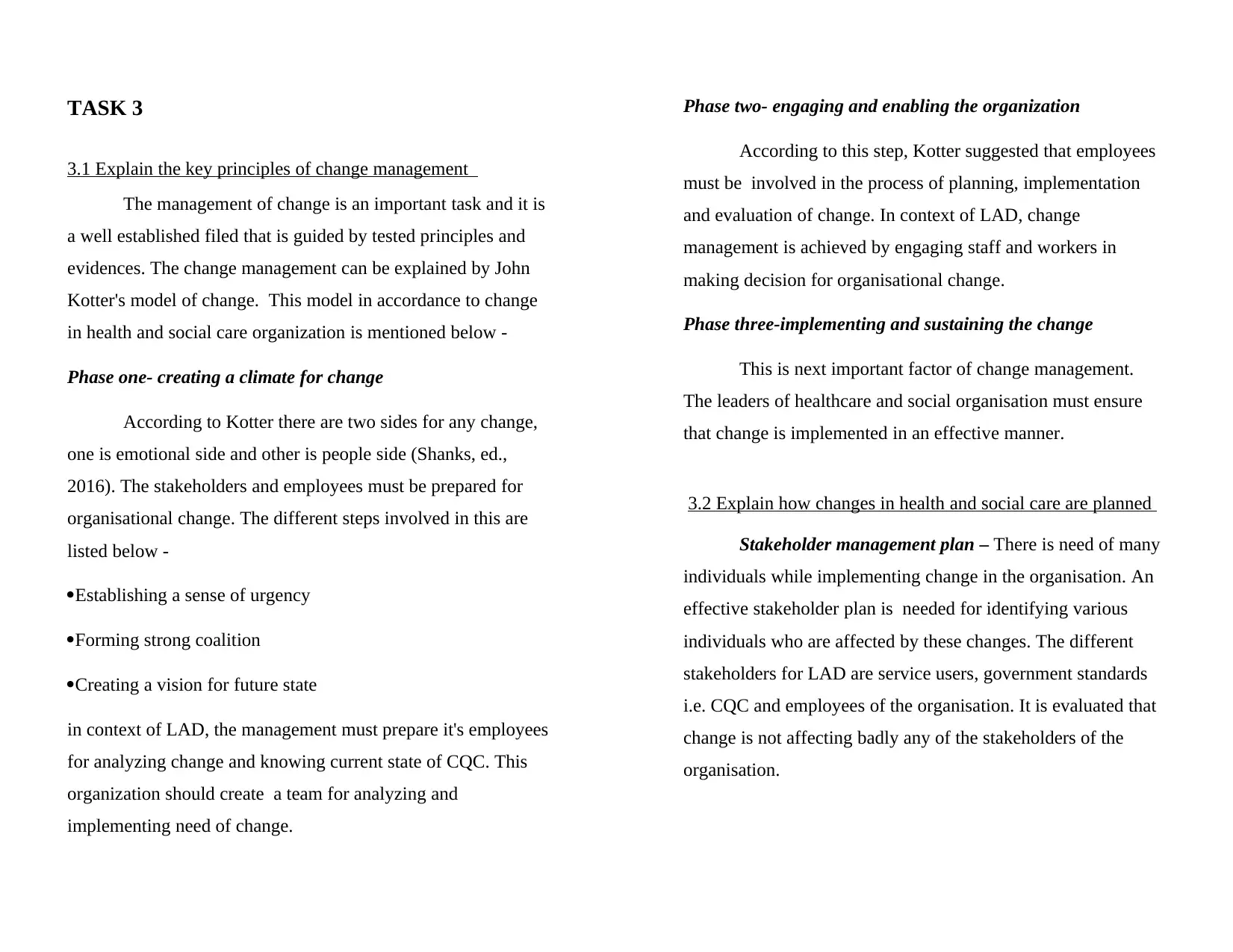
TASK 3
3.1 Explain the key principles of change management
The management of change is an important task and it is
a well established filed that is guided by tested principles and
evidences. The change management can be explained by John
Kotter's model of change. This model in accordance to change
in health and social care organization is mentioned below -
Phase one- creating a climate for change
According to Kotter there are two sides for any change,
one is emotional side and other is people side (Shanks, ed.,
2016). The stakeholders and employees must be prepared for
organisational change. The different steps involved in this are
listed below -
Establishing a sense of urgency
Forming strong coalition
Creating a vision for future state
in context of LAD, the management must prepare it's employees
for analyzing change and knowing current state of CQC. This
organization should create a team for analyzing and
implementing need of change.
Phase two- engaging and enabling the organization
According to this step, Kotter suggested that employees
must be involved in the process of planning, implementation
and evaluation of change. In context of LAD, change
management is achieved by engaging staff and workers in
making decision for organisational change.
Phase three-implementing and sustaining the change
This is next important factor of change management.
The leaders of healthcare and social organisation must ensure
that change is implemented in an effective manner.
3.2 Explain how changes in health and social care are planned
Stakeholder management plan – There is need of many
individuals while implementing change in the organisation. An
effective stakeholder plan is needed for identifying various
individuals who are affected by these changes. The different
stakeholders for LAD are service users, government standards
i.e. CQC and employees of the organisation. It is evaluated that
change is not affecting badly any of the stakeholders of the
organisation.
3.1 Explain the key principles of change management
The management of change is an important task and it is
a well established filed that is guided by tested principles and
evidences. The change management can be explained by John
Kotter's model of change. This model in accordance to change
in health and social care organization is mentioned below -
Phase one- creating a climate for change
According to Kotter there are two sides for any change,
one is emotional side and other is people side (Shanks, ed.,
2016). The stakeholders and employees must be prepared for
organisational change. The different steps involved in this are
listed below -
Establishing a sense of urgency
Forming strong coalition
Creating a vision for future state
in context of LAD, the management must prepare it's employees
for analyzing change and knowing current state of CQC. This
organization should create a team for analyzing and
implementing need of change.
Phase two- engaging and enabling the organization
According to this step, Kotter suggested that employees
must be involved in the process of planning, implementation
and evaluation of change. In context of LAD, change
management is achieved by engaging staff and workers in
making decision for organisational change.
Phase three-implementing and sustaining the change
This is next important factor of change management.
The leaders of healthcare and social organisation must ensure
that change is implemented in an effective manner.
3.2 Explain how changes in health and social care are planned
Stakeholder management plan – There is need of many
individuals while implementing change in the organisation. An
effective stakeholder plan is needed for identifying various
individuals who are affected by these changes. The different
stakeholders for LAD are service users, government standards
i.e. CQC and employees of the organisation. It is evaluated that
change is not affecting badly any of the stakeholders of the
organisation.
⊘ This is a preview!⊘
Do you want full access?
Subscribe today to unlock all pages.

Trusted by 1+ million students worldwide
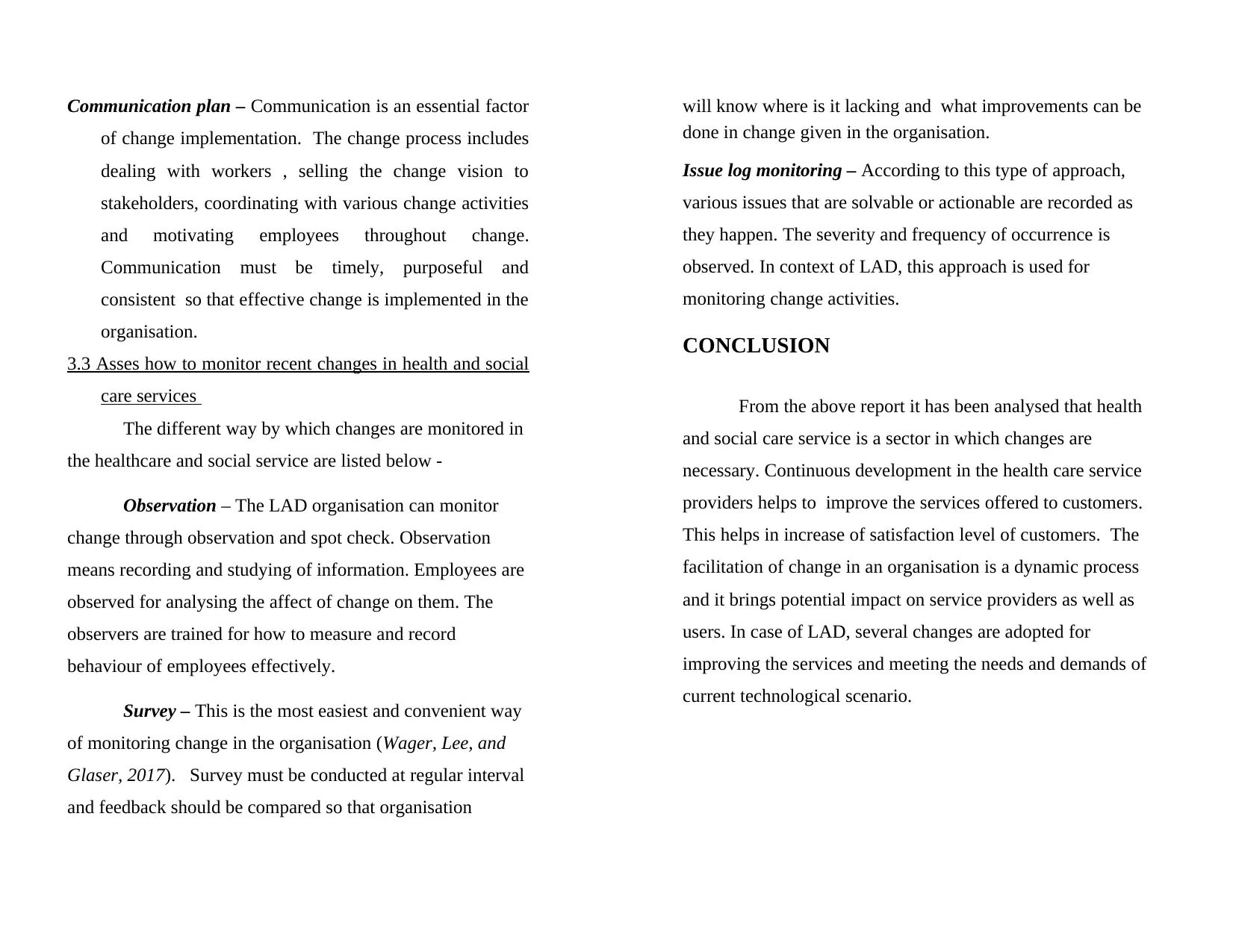
Communication plan – Communication is an essential factor
of change implementation. The change process includes
dealing with workers , selling the change vision to
stakeholders, coordinating with various change activities
and motivating employees throughout change.
Communication must be timely, purposeful and
consistent so that effective change is implemented in the
organisation.
3.3 Asses how to monitor recent changes in health and social
care services
The different way by which changes are monitored in
the healthcare and social service are listed below -
Observation – The LAD organisation can monitor
change through observation and spot check. Observation
means recording and studying of information. Employees are
observed for analysing the affect of change on them. The
observers are trained for how to measure and record
behaviour of employees effectively.
Survey – This is the most easiest and convenient way
of monitoring change in the organisation (Wager, Lee, and
Glaser, 2017). Survey must be conducted at regular interval
and feedback should be compared so that organisation
will know where is it lacking and what improvements can be
done in change given in the organisation.
Issue log monitoring – According to this type of approach,
various issues that are solvable or actionable are recorded as
they happen. The severity and frequency of occurrence is
observed. In context of LAD, this approach is used for
monitoring change activities.
CONCLUSION
From the above report it has been analysed that health
and social care service is a sector in which changes are
necessary. Continuous development in the health care service
providers helps to improve the services offered to customers.
This helps in increase of satisfaction level of customers. The
facilitation of change in an organisation is a dynamic process
and it brings potential impact on service providers as well as
users. In case of LAD, several changes are adopted for
improving the services and meeting the needs and demands of
current technological scenario.
of change implementation. The change process includes
dealing with workers , selling the change vision to
stakeholders, coordinating with various change activities
and motivating employees throughout change.
Communication must be timely, purposeful and
consistent so that effective change is implemented in the
organisation.
3.3 Asses how to monitor recent changes in health and social
care services
The different way by which changes are monitored in
the healthcare and social service are listed below -
Observation – The LAD organisation can monitor
change through observation and spot check. Observation
means recording and studying of information. Employees are
observed for analysing the affect of change on them. The
observers are trained for how to measure and record
behaviour of employees effectively.
Survey – This is the most easiest and convenient way
of monitoring change in the organisation (Wager, Lee, and
Glaser, 2017). Survey must be conducted at regular interval
and feedback should be compared so that organisation
will know where is it lacking and what improvements can be
done in change given in the organisation.
Issue log monitoring – According to this type of approach,
various issues that are solvable or actionable are recorded as
they happen. The severity and frequency of occurrence is
observed. In context of LAD, this approach is used for
monitoring change activities.
CONCLUSION
From the above report it has been analysed that health
and social care service is a sector in which changes are
necessary. Continuous development in the health care service
providers helps to improve the services offered to customers.
This helps in increase of satisfaction level of customers. The
facilitation of change in an organisation is a dynamic process
and it brings potential impact on service providers as well as
users. In case of LAD, several changes are adopted for
improving the services and meeting the needs and demands of
current technological scenario.
Paraphrase This Document
Need a fresh take? Get an instant paraphrase of this document with our AI Paraphraser
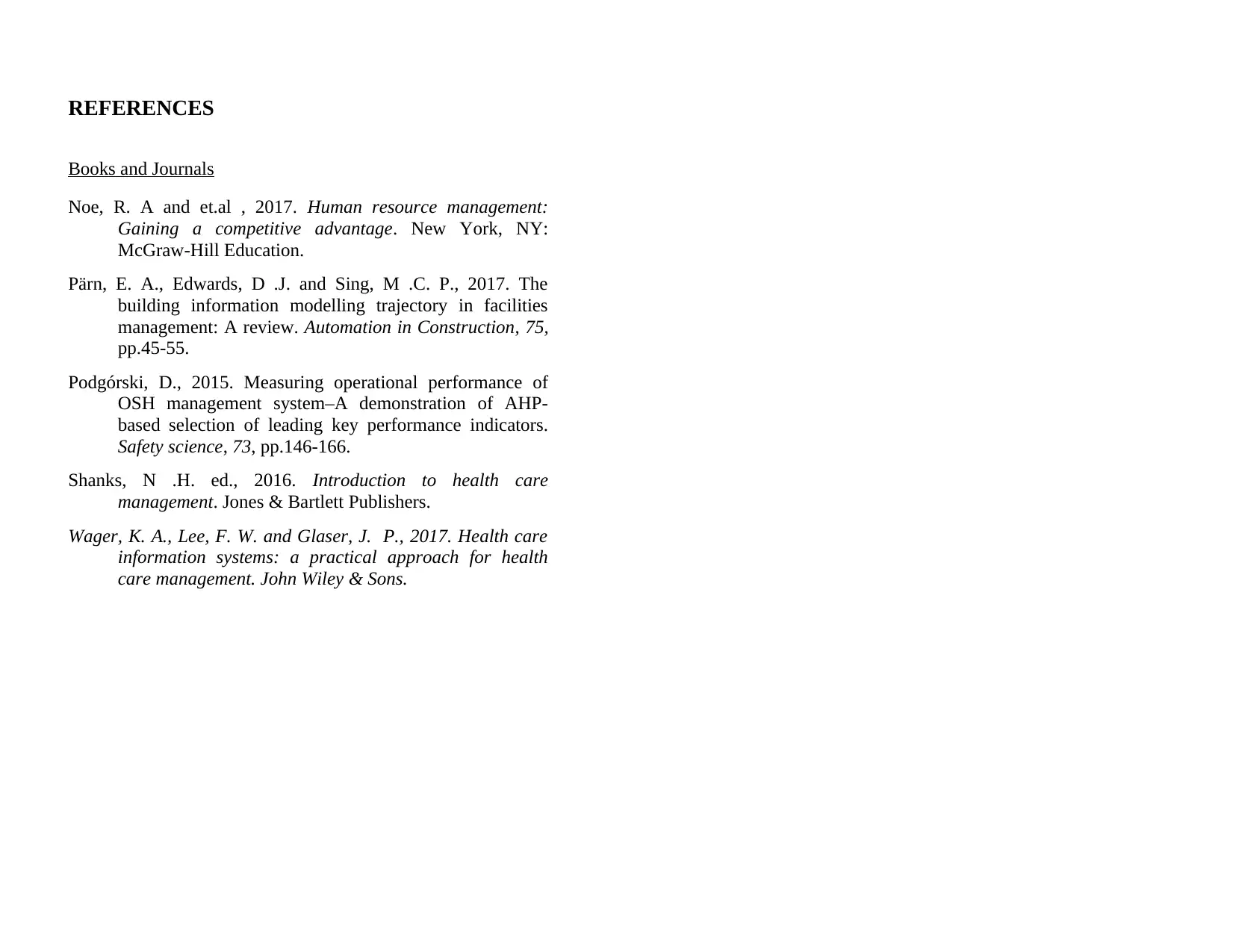
REFERENCES
Books and Journals
Noe, R. A and et.al , 2017. Human resource management:
Gaining a competitive advantage. New York, NY:
McGraw-Hill Education.
Pärn, E. A., Edwards, D .J. and Sing, M .C. P., 2017. The
building information modelling trajectory in facilities
management: A review. Automation in Construction, 75,
pp.45-55.
Podgórski, D., 2015. Measuring operational performance of
OSH management system–A demonstration of AHP-
based selection of leading key performance indicators.
Safety science, 73, pp.146-166.
Shanks, N .H. ed., 2016. Introduction to health care
management. Jones & Bartlett Publishers.
Wager, K. A., Lee, F. W. and Glaser, J. P., 2017. Health care
information systems: a practical approach for health
care management. John Wiley & Sons.
Books and Journals
Noe, R. A and et.al , 2017. Human resource management:
Gaining a competitive advantage. New York, NY:
McGraw-Hill Education.
Pärn, E. A., Edwards, D .J. and Sing, M .C. P., 2017. The
building information modelling trajectory in facilities
management: A review. Automation in Construction, 75,
pp.45-55.
Podgórski, D., 2015. Measuring operational performance of
OSH management system–A demonstration of AHP-
based selection of leading key performance indicators.
Safety science, 73, pp.146-166.
Shanks, N .H. ed., 2016. Introduction to health care
management. Jones & Bartlett Publishers.
Wager, K. A., Lee, F. W. and Glaser, J. P., 2017. Health care
information systems: a practical approach for health
care management. John Wiley & Sons.

⊘ This is a preview!⊘
Do you want full access?
Subscribe today to unlock all pages.

Trusted by 1+ million students worldwide

Paraphrase This Document
Need a fresh take? Get an instant paraphrase of this document with our AI Paraphraser

1 out of 8
Related Documents
Your All-in-One AI-Powered Toolkit for Academic Success.
+13062052269
info@desklib.com
Available 24*7 on WhatsApp / Email
![[object Object]](/_next/static/media/star-bottom.7253800d.svg)
Unlock your academic potential
Copyright © 2020–2025 A2Z Services. All Rights Reserved. Developed and managed by ZUCOL.




